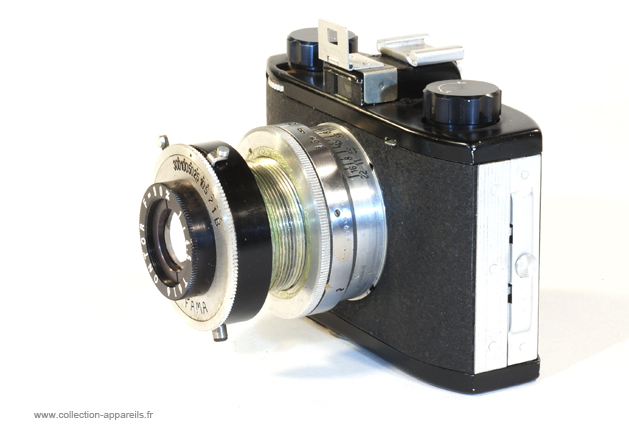|
Cornu Fama II |
Manufactured or assembled in France from 1958 to 1961.
Index of rarity in France: Rare (among non-specialized garage sales)
Inventory number: 6444
See the complete technical specifications
Chronology of cameras Cornu
Around 1940, Cornu requested Aluvac to cast the bodies and backs of a small 24 x 36 camera in aluminum. These parts were marked as Aluvac 3439 and Aluvac 3440. These components were used for about two decades by two companies to produce numerous popular camera models.
The Société des Établissements Modernes de Mécanique Générale et de Décolletage Jean Cros was established in Saint-Étienne just before 1939 with state funding to support the war effort. Jean Cros had Aluvac mold rocket fins for him.
After the defeat, Jean Cros, forced to refocus his activities in the civilian sector, considered entering the camera manufacturing business. He reconnected with Paul Royet, who had been a "special assignment" employee in his factory until his demobilization, to offer him the position of Director of the photographic section, where everything had to be created from scratch.
In 1941, Jean Cros, the director of SEMM, obtained a license from Cornu to manufacture a camera in Saint-Étienne using these parts. Paul Royet, the future director of SEM, successfully carried out this project
In Saint-Étienne, the Reyna-Cross cameras were built using the original body, but for the Sem Kim, the front plate was reduced in thickness. To accommodate this change, Cornu decided to create a camera with interchangeable lenses, following the Leica standard in terms of thread and focal distance. However, in this case, each lens had its own shutter.
This design concept was also used for the Week-End and Week-End camera models.
The Fama camera would be exclusive to the Maillard company, and its distribution would be quite limited.
Similar to the Ontobloc II and III models, the viewfinder came with an attached cover. What set these models apart primarily was the viewfinder's ability to frame for one, two, three, or four different focal lengths using a set of sliding masks.
This is a Fama II, as it features an internal shutter allowing lens changes without exposing the film, but it does not yet have the tri-format viewfinder.
One could consider this camera as a standard model equipped with a small telephoto lens and its framing accessory, although it likely originated in this configuration. In any case, it rightfully deserves its place here, proudly displaying black lacquered buttons that add a touch of elegance. This very pleasing presentation will not be overlooked.
The small foldable frame, crafted from the same hinge used for the body, is fixed onto a small support that friction-fits onto the viewfinder.
The flash shoe is directly riveted onto the viewfinder.
This model foreshadows the upcoming Fama II with the tri-format viewfinder.


Interesting links or bibliography :
Add a link or element of bibliography, a picture taken with this camera, a picture of box or an ads about this camera
Your photos taken with the same camera:
Cameras from Ebay France (Cornu) (Uploaded each 3 hours)







